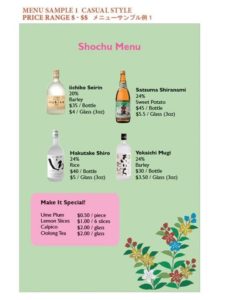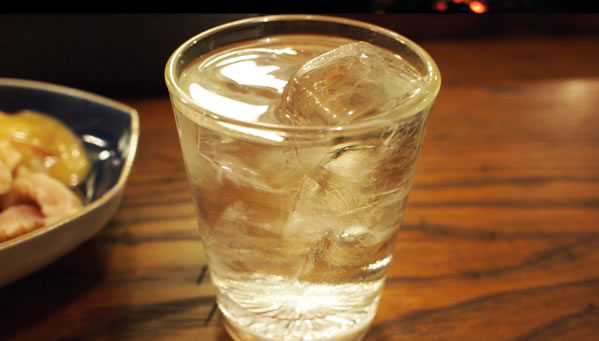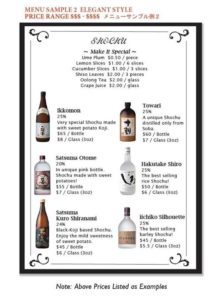Discovering Shochu: Episode 16 – Creating a Menu That Works
A menu that’s concise and straightforward is effective in enticing more Shochu drinkers. To start, the first important step is to evaluate the restaurant surroundings, configuration and the main characteristics that define its key positioning. Also, design an all-inclusive alcoholic beverage menu, together with Sake and beer. The final step is to meld these points into a harmonized, complete menu listing.
The following is a time-saving summary on creating a basic Shochu menu. It provides a good starting point that can be extended and customized for each individual food establishment’s needs.
Overall Considerations
Local Characteristics: Once again, defining the restaurant’s unique and area characteristic is very important. Investigate the surroundings, analyze how the area offerings and demographics affect the food business, and identify the visitors who would come eat and drink. This study is a necessity in order to set the framework on the number of products, price bracket, and frequency of menu renewals.
Target Group: What group of customers would be the main focus of Shochu sales? Japanese or Americans? Men or women? What age range? Identifying a clear demographic target will define their general lifestyle, likes and dislikes, thus help make decisions on product selection, serving styles, and menu communication.
Product Descriptions and Photos: Using all resources including the breweries, gather as many flavor descriptions and photos of the products as possible. Most often, copywork styles and photography angles will vary from one brewery to the next, therefore, time for editing and reformatting for menu use is required.
Tasting: Understanding each Shochu takes training. The practice of tasting them and noting the flavors down from time to time, leads to the creation of unique and original tasting notes.
Motivating the Customers
Make it Attractive: Shochu as a unique Japanese spirit has not yet reached common recognition among Americans. Therefore, to familiarize the category, what better way is there than to include simple explanations right on the menu: what is it and how to enjoy it best?
Laying out the menu in a succinct and informative manner relays the image of a restaurant providing intangible services to benefit the customer. These may include information on Shochu ingredients, brewery origin, and serving sizes by the ounce (by bottle, carafe, glass). Further, explanation on the Warizai, or mixers, can be creative: with fresh fruit, juices, teas, and tonics, all with clearly marked corresponding prices. Shochu Health Benefits: Although a number of medical studies in Japan have substantiated many health benefits of Shochu, that claim cannot be transferred for use in the US. However, the low-calorie claim, and that Shochu contains the enzyme Urokinase which helps break up blood clots, is a fact that many alcohol consumers would be interested in.
Suitable Price Setting: In today’s tough economic times, the dining public have become highly price conscious. Therefore, in order to accommodate the customer, dining establishments cannot afford the old trade practice of simply doubling or tripling the cost to set menu prices. Rather, careful calculation based on profit margins, especially on expensive brews, would help reach a pricing point more attractive to today’s diners.
Buying Motivation: Using key words that clearly describe and differentiate one product from another, encourages drinkers to explore multiple styles of Shochu. For instance, “Real/Honkaku” (the traditional single distillation Shochu), versus catchy contemporary phrases as “world renown” and “popular”, describe products from different time periods. A guest may want to compare both in one sitting.
Quality Choices: A restaurant diner likes to be offered choices, and wants to drink high quality liquor. Offering a broad range of Shochu quality, from high to low, would appease the guest who’d like to see the entire quality offering before making the selection. Food Pairing: Since Shochu pairs well with a variety of foods, menu recommendations such as “XX Shochu goes well with XX dish” or “We recommend XX Shochu with XX” are extremely helpful. This leads to an improved dining experience, and a very happy customer.
Variety: In today’s tech-savvy world, more of the drinking and eating public is exploring various kinds of Shochu. Appealing to their intellect is another good tactic: arranging products by location, ingredient, particular distillation method, or aging period. The curious customer may be motivated to delve into one type, or try a variety. Nevertheless, providing the catalyst to prompt curiosity and interest will expand Shochu sales. This also includes adding new products to manage these curiosity seekers. Reflecting the Seasons: Japanese culture and the four seasons are closely weaved in, and thus their cuisine takes great effort in highlighting them. In America, however, that sentiment is not as strong. Therefore, providing that seasonal connection, in food and its complementary Shochu, would greatly advance the culinary offering, even in “season-less” areas such as Southern California. Association to holidays, festivals, and the seasons can strike at the gentle sentiment of the dining guest. 






Comments